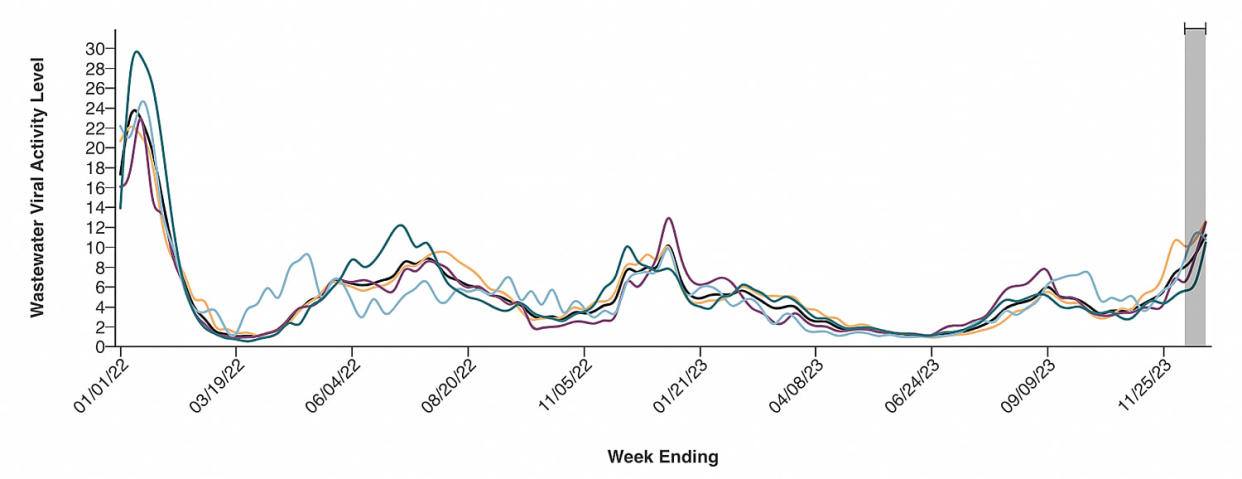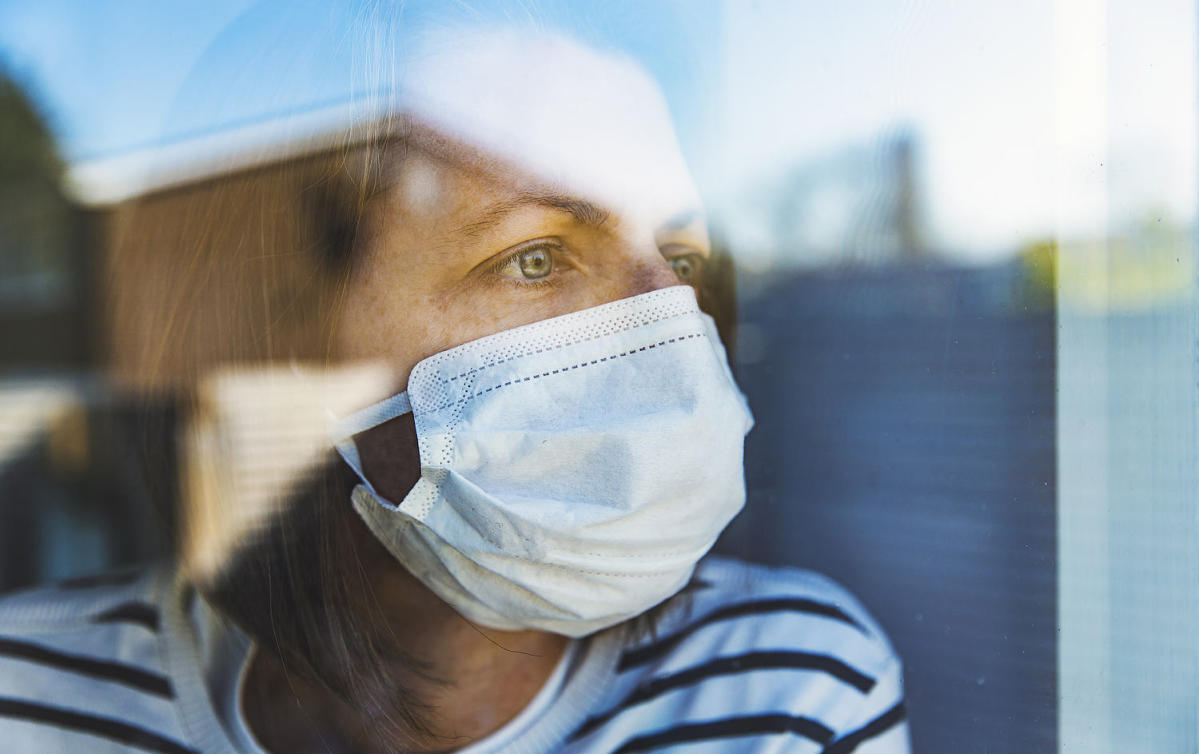The United States is in the middle of a wintertime COVID wave, driven by holiday gatherings, people spending more time inside, waning immunity from low uptake of the new COVID vaccine and a new highly infectious COVID variant, JN.1.
A viral social media post based on data from the U.S. Centers of Disease Control and Prevention is calling this surge the second-biggest COVID wave in the history of the U.S. — after the omicron surge from late 2021 to early 2022, which infected more people than even the early days of the pandemic.
Lucky Tran, Ph.D., science communicator at Columbia University Irving Medical Center, compiled the CDC data into a graph, which has been shared widely on Instagram and X, formerly known as Twitter.
Tran also said in his post that projections show as many as 1 in 3 people in the U.S. could be infected with COVID during the peak months of the current wave and up to 2 million people could be infected in a single day — data he attributed to Michael Hoerger, Ph.D., assistant professor at Tulane University School of Medicine who leads the Pandemic Mitigation Collaborative’s data tracker.
Tran tells TODAY.com he was motivated to share the data on the current levels of virus circulating because “many people underestimate just how much virus is around,” and that research shows once people are aware of the real levels, “they were more willing to wear a mask, social distance when required, to stay home and get vaccinated and take all of those measures. That’s why it’s so important to do this.”
Is the U.S. in a COVID wave in 2024?
Yes, the U.S. is in the middle of a COVID wave, multiple experts tell TODAY.com.
The CDC no longer tracks positive COVID tests and instead relies on presence of the virus wastewater to determine how widespread it is.
Indeed, a CDC chart of national and regional COVID trends in wastewater shows the national viral activity rate of 11.23 from the week ending Dec. 23, 2023 (the most recent data available) is higher than anything seen since January 2022, as far back as the publicly available CDC data goes. The national rate for the week ending Jan. 15, 2022, was 22.78. What’s more, the next round of CDC wastewater data may show a further rise in viral activity after accounting for infections from Christmas gatherings, experts say.

CDC spokesperson Tom Skinner tells TODAY.com via email that “COVID 19 in wastewater is currently (at) very high levels across the country. Wastewater data are similar looking very similar to last year, both in levels and timing.” (The late 2022 peak in the CDC graph shows a viral activity level of 10.16.)
“Last year, the peak of infections occurred in late December, early January. We are seeing early evidence of the same timing this year, but we will continue to monitor closely. There is some early evidence that COVID levels may be coming down, particularly in the Northeast and Midwest,” Skinner continues.
“These levels are much lower than the Omicron wave in early 2022,” he says, adding that JN.1 is the most frequently detected variant in wastewater. Skinner did not specify if the current COVID wave is the country’s second-largest.
Hoerger tells TODAY.com that based on the wastewater data collected from Biobot Analytics (which used to provide the CDC its wastewater data), the U.S. is in its second-largest COVID surge. He says his own predictive model indicates cases will continue to rise until mid-February. He estimates that mid-December 2023 to mid-February 2024 will be the peak of the current wave and that 1 in 3 Americans will be infected with COVID during this timeframe.
He says his data also show that on the highest day of the current wave, there will be 2 million new COVID cases, which would lend to many more infections than last winter, which had its highest day of about 1.7 million new infections. While CDC data suggest viral activity levels have been similar the last two Decembers, Hoerger explains that the acceleration in COVID activity in 2023 was faster than in 2022, suggesting there will be a higher peak this season.
“I think people can get a little bit too concerned about the height of the peak,” Hoerger says. “What’s really troubling is just the total number of days with a really high transmission based on my model or if you’re just looking at the wastewater.”
Dr. Albert Ko, infectious disease physician and professor of public health, epidemiology and medicine at Yale School of Public Health, agrees that focusing on peaks isn’t as helpful as stressing that COVID is spreading widely in much of the country right now.
“More important than saying this is more than the last wave or two waves or three waves ago … is that we are getting into surge, and the public should be aware about how to protect themselves,” Ko tells TODAY.com.
A surge this time of year is expected, Dr. William Schaffner, infectious disease specialist at Vanderbilt University Medical Center, tells TODAY.com, and it’s “perfectly reasonable” to call the current COVID wave the country’s second-largest, he says.
“But I don’t want to panic people,” he explains. “This winter increase is not going to be akin to the previous winter increases, which really stressed hospitals,” though it is likely to keep medical professionals “very busy,” he adds.
Tran stresses that it’s important to understand of the burden of COVID beyond hospitalizations and deaths being lower than they were earlier in the pandemic.
“While we’re not seeing the same levels of hospitalizations or deaths as 2020 or 2021, it’s still a very high baseline compared with before the pandemic, and that’s something that we should still care about,” Tran says. He adds that more virus circulating can also lead to increases in long COVID and chronic illness, more people (especially health care workers) missing work and other important events, and immunocompromised people not being able to access essential services, like health care.
COVID-19 mask mandates
Amid a rise in COVID cases, as well as influenza and respiratory syncytial virus (RSV), masks mandates have returned in medical settings in several states, Reuters reported:
-
New York
-
Illinois
-
Massachusetts
-
California
But even if you’re not required to mask, the experts say that now is a good time to wear your N95 or KN95.
“Get your mask out again if you’re going indoors, even to the supermarket,” Schaffner says. “Certainly if you’re traveling, going to religious services, going to that basketball game, where everybody’s close together and cheering, those are environments where the virus can spread.”
How bad is the new COVID variant?
The new COVID variant JN.1 is responsible for more than 61% of cases in the U.S. as of the week ending Jan. 6, 2024, according to CDC data. The variant may be more transmissible or better at evading immune protection than previous COVID variants, TODAY.com previously reported.
That said, it doesn’t seem to be causing more severe illness than previous variants and the symptoms associated with it are similar to those that have been prevalent the entire COVID-19 pandemic.
JN.1 COVID variant symptoms
The symptoms you’ll experience if infected by the latest COVID variant, JN.1, will depend on your underlying health and immunity. But generally speaking JN.1 symptoms are similar to those caused by other variants, such as HV.1 and BA.2.86, aka “Pirola.”
According to the CDC, these are:
How to protect yourself in a COVID wave
The experts all agree that the current rate of new COVID cases means it’s time to take precautions to prevent further spread. This is especially important for individuals who are at high risk for severe illness, such as the elderly and immunocompromised.
But even if you or loved ones don’t fall into this category, by taking precautions, you can prevent spreading the virus to someone who may get much sicker than you and reduce your risk of long COVID.
So, the experts urge:
-
Wearing a mask in indoor settings with lots of people
-
Considering avoiding crowded settings, especially if you’re high risk
-
Staying home if you’re sick
-
COVID testing
-
Getting the new COVID vaccine, approved for everyone ages 6 months and older since September 2023
-
Seek out antivirals if you test positive for COVID, especially if you’re high risk
It’s tempting to think the pandemic is over, but Hoerger stresses that data show it isn’t. In fact, a leading World Health Organization official recently posted on X that we’re heading into the fifth year of the pandemic.
“The bottom line,” Ko says, “is everybody should consider themselves under risk of getting COVID.”
This article was originally published on TODAY.com

Rachel Carter is a health and wellness expert dedicated to helping readers lead healthier lives. With a background in nutrition, she offers evidence-based advice on fitness, nutrition, and mental well-being.








